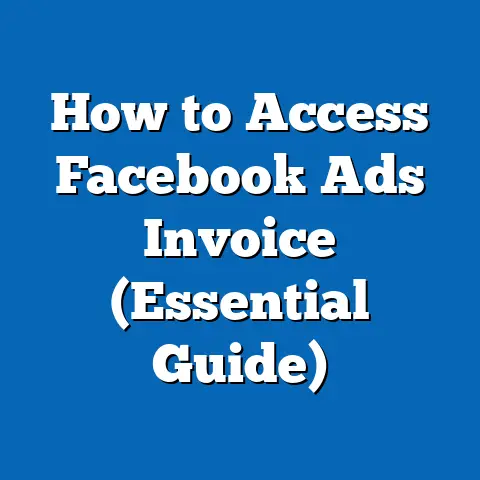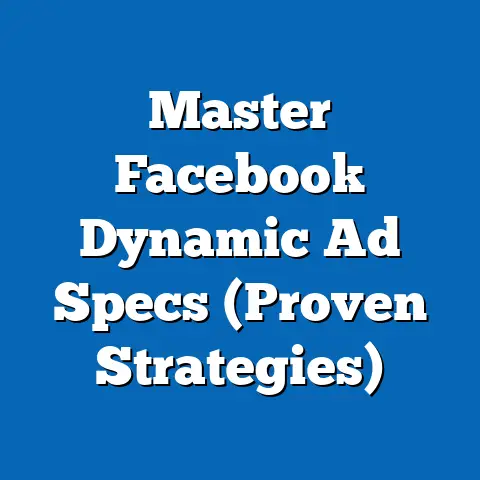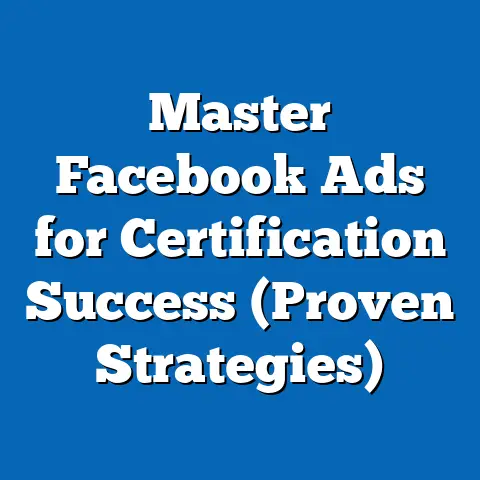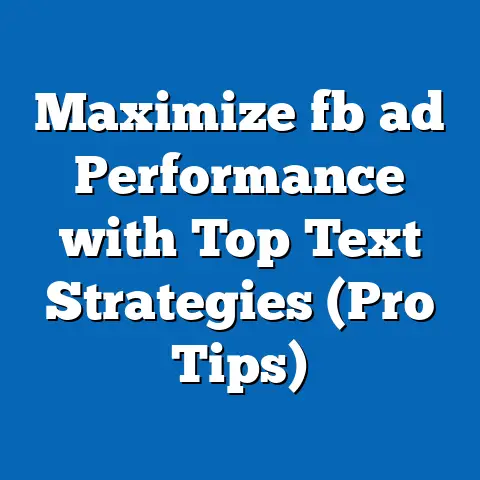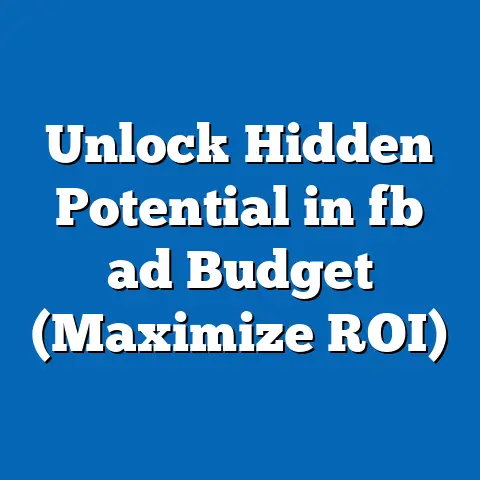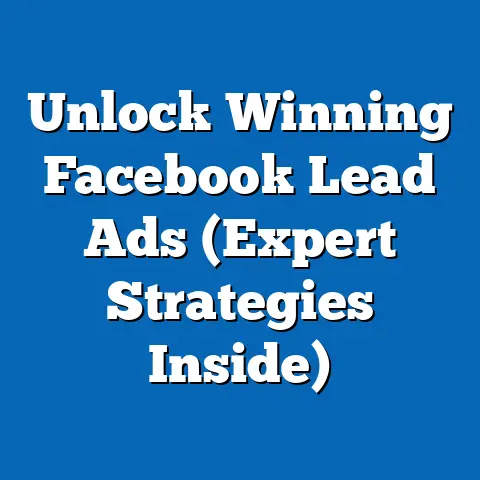Unlock College Access with Facebook Ads (Proven Strategies)
Unlock College Access with Facebook Ads: Proven Strategies
In today’s fast-paced educational landscape, standing still is the same as falling behind. Gone are the days when traditional recruitment methods were enough to fill classrooms. With changing demographics and evolving student expectations, institutions need to be agile and innovative to stay ahead of the curve. That’s where Facebook comes into play. It’s not just a social network; it’s a powerful platform for colleges and universities to attract and engage potential students like never before.
I’ve seen firsthand how effective a well-crafted Facebook ad campaign can be. A few years back, I helped a small liberal arts college in the Midwest revamp their recruitment strategy. They were struggling to reach students outside their immediate geographic area. By leveraging Facebook Ads, we were able to target specific demographics, interests, and even “lookalike audiences” (more on that later), resulting in a significant increase in applications from out-of-state students. It was a real eye-opener for them, and it solidified my belief in the power of this platform.
The increasing reliance on digital marketing, especially social media, isn’t just a trend; it’s a necessity. Students are online, and colleges need to meet them where they are. In this article, I’m going to share proven strategies to help your institution unlock college access using Facebook Ads.
Understanding Your Audience
Before you even think about crafting an ad, you need to know who you’re talking to. Defining your target audience is paramount to the success of any college access initiative. It’s like shooting an arrow – you need to know where the bullseye is before you let it fly.
Facebook boasts a massive user base, and within that sea of profiles are high school students, parents, non-traditional students, and countless others who might be interested in your institution. But reaching them effectively requires more than just casting a wide net. You need to understand their specific interests, behaviors, and needs.
Demographics: Consider the age ranges you’re targeting. Are you primarily focused on high school juniors and seniors? Or are you also looking to attract transfer students or adult learners? Understanding the age demographics will influence your messaging and imagery.
Interests: What are your potential students interested in? Are they passionate about STEM fields, the arts, or social justice? Facebook allows you to target users based on their declared interests and the pages they follow.
Behaviors: How do your potential students behave online? Are they actively researching colleges? Do they engage with educational content? Facebook tracks user behavior, allowing you to target those who are actively in the market for higher education.
Needs: What are the pain points of your target audience? Are they worried about affordability, academic rigor, or campus life? Understanding their needs will help you craft ads that address their concerns and offer solutions.
Creating Student Personas: One of the most effective ways to understand your audience is by creating student personas. These are fictional representations of your ideal students, based on research and data. Give them names, backgrounds, and motivations. For example:
- “Sarah, the Aspiring Engineer”: A high school senior passionate about STEM, worried about finding an affordable program with strong research opportunities.
- “David, the Transfer Student”: A community college student looking for a four-year university with a smooth transfer process and a vibrant campus community.
- “Maria, the Adult Learner”: A working professional looking to advance her career with a flexible online degree program.
By creating these personas, you can tailor your messaging and ad creative to resonate with specific segments of your audience.
Takeaway: Know your audience inside and out. Research their demographics, interests, behaviors, and needs. Create student personas to guide your messaging and targeting.
Crafting Compelling Ad Content
Once you know who you’re talking to, it’s time to craft ad content that grabs their attention and compels them to take action. Think of your ad as a tiny billboard in a sea of distractions. It needs to be visually appealing, informative, and persuasive.
Elements of Effective Ad Copy:
- Headline: This is the first thing people will see, so make it count. Use strong, attention-grabbing language that speaks to the needs and interests of your target audience. For example: “Unlock Your Future: Explore [College Name]’s Cutting-Edge Programs” or “Worried About College Costs? [College Name] Offers Generous Financial Aid.”
- Image or Video: Visuals are crucial for capturing attention. Use high-quality images or videos that showcase your campus, students, and academic programs. Consider using images of diverse students to represent the diversity of your institution.
- Body Copy: This is where you provide more information about your institution and its offerings. Keep it concise and focused on the benefits of attending your college. Highlight unique programs, research opportunities, campus amenities, and student support services.
- Call to Action (CTA): Tell people what you want them to do next. Use clear and compelling CTAs like “Apply Now,” “Learn More,” “Visit Campus,” or “Download Our Brochure.”
The Power of Storytelling:
People connect with stories. Share success stories from alumni who have gone on to achieve great things. Highlight the personal growth and transformative experiences that students have had at your institution. For example, you could feature a video testimonial from a recent graduate who landed their dream job after completing a specific program.
Engaging Ad Formats:
- Carousel Ads: These allow you to showcase multiple images or videos in a single ad. Use them to highlight different aspects of your campus, academic programs, or student life.
- Video Ads: Video is incredibly engaging, especially on social media. Create short, compelling videos that capture the essence of your institution and its unique offerings.
- Slideshow Ads: These are a cost-effective way to create video-like content using existing images. Use them to showcase campus life, academic programs, and student support services.
Clarity and Conciseness:
In the crowded world of social media, attention spans are short. Make sure your messaging is clear, concise, and easy to understand. Avoid jargon and focus on the key benefits of attending your institution.
Example:
Let’s say you’re trying to attract students to your engineering program. Here’s an example of an effective Facebook ad:
Leveraging Targeting Options
Facebook Ads offer a wealth of targeting options that allow you to reach specific groups of people with laser-like precision. This is where the real magic happens. Instead of throwing your message out to the masses, you can target those who are most likely to be interested in your institution.
Geographic Targeting:
This allows you to target people based on their location. You can target specific cities, states, or even countries. This is particularly useful if you’re trying to attract students from a specific geographic region.
Interest Targeting:
This allows you to target people based on their declared interests and the pages they follow. For example, you could target people who are interested in “college,” “universities,” “engineering,” or “pre-med.”
Demographic Targeting:
This allows you to target people based on their age, gender, education level, and other demographic factors. This is useful for targeting specific age groups, such as high school juniors and seniors, or for targeting parents of college-bound students.
Behavioral Targeting:
This allows you to target people based on their online behavior. For example, you could target people who are actively researching colleges or who have visited college websites.
Lookalike Audiences:
This is one of the most powerful targeting options available on Facebook. It allows you to create audiences that are similar to your existing customers or website visitors. Facebook analyzes the characteristics of your existing audience and identifies other users who share similar traits. This is a great way to reach new potential students who are likely to be interested in your institution.
Custom Audiences:
These allow you to target people who have already interacted with your institution, such as website visitors or email subscribers. You can upload your email list to Facebook and target those individuals with specific ads. You can also create custom audiences based on people who have visited specific pages on your website.
Retargeting Campaigns:
Retargeting is a powerful strategy for re-engaging previous prospects. If someone has visited your website but hasn’t yet applied, you can show them targeted ads that remind them of your institution and encourage them to take the next step.
Example:
Let’s say you’re trying to reach underrepresented populations. You could use interest targeting to target people who are interested in organizations like the NAACP or the Hispanic Scholarship Fund. You could also use demographic targeting to target people from specific ethnic backgrounds.
Takeaway: Leverage Facebook’s targeting options to reach specific groups of people who are most likely to be interested in your institution. Use geographic targeting, interest targeting, demographic targeting, behavioral targeting, lookalike audiences, custom audiences, and retargeting campaigns.
Budgeting and Ad Spend
Establishing a budget for Facebook Ads is crucial, but it doesn’t have to be intimidating. It’s about allocating your resources effectively and monitoring your results to ensure you’re getting the best return on your investment.
Setting a Budget:
Start by determining how much you can realistically afford to spend on Facebook Ads. Consider your overall marketing budget and allocate a portion of it to Facebook advertising. It’s often wise to start with a smaller budget and scale up as you see positive results.
Bidding Strategies:
Facebook offers a variety of bidding strategies, each with its own pros and cons.
- Cost-Per-Click (CPC): With CPC bidding, you only pay when someone clicks on your ad. This is a good option if your primary goal is to drive traffic to your website.
- Cost-Per-Impression (CPM): With CPM bidding, you pay for every 1,000 impressions your ad receives. This is a good option if your primary goal is to increase brand awareness.
- Cost-Per-Acquisition (CPA): With CPA bidding, you only pay when someone takes a specific action, such as submitting an application or requesting more information. This is the most performance-driven bidding strategy, but it requires careful tracking and optimization.
Choosing the Right Bidding Strategy:
The best bidding strategy for you will depend on your campaign objectives. If you’re just starting out, CPC bidding is a good option because it allows you to control your costs and track your results easily. As you become more experienced, you can experiment with other bidding strategies.
Monitoring Ad Performance:
It’s crucial to monitor your ad performance regularly to ensure you’re getting the best return on your investment. Track key metrics like click-through rates (CTR), conversion rates, and cost per acquisition (CPA).
Adjusting Budgets:
Based on your ad performance, you may need to adjust your budgets. If you’re seeing positive results, you may want to increase your budget to reach a wider audience. If you’re not seeing the results you want, you may need to decrease your budget or adjust your targeting and ad creative.
Takeaway: Establish a budget for Facebook Ads and allocate your resources effectively. Choose the right bidding strategy based on your campaign objectives. Monitor your ad performance regularly and adjust your budgets as needed.
Analyzing and Optimizing Campaigns
The beauty of digital marketing lies in its measurability. You’re not just throwing money into the void; you’re tracking results and making data-driven decisions to improve your performance. Analytics are your best friend when it comes to Facebook Ads.
Key Metrics to Track:
- Click-Through Rate (CTR): This is the percentage of people who see your ad and click on it. A high CTR indicates that your ad is relevant and engaging to your target audience.
- Conversion Rate: This is the percentage of people who click on your ad and then take a desired action, such as submitting an application or requesting more information. A high conversion rate indicates that your website is effective at converting visitors into leads.
- Cost Per Acquisition (CPA): This is the average cost of acquiring a new lead or customer. A low CPA indicates that your ad campaign is cost-effective.
- Reach: The number of unique people who saw your ad.
- Impressions: The number of times your ad was displayed.
- Frequency: The average number of times each person saw your ad.
Using Facebook Ads Manager:
Facebook Ads Manager is your central hub for tracking and analyzing your ad performance. It provides a wealth of data and insights that can help you optimize your campaigns.
Generating Reports:
Use Facebook Ads Manager to generate reports that track key metrics and provide insights into audience behavior and ad performance.
Analyzing Data:
Analyze the data in your reports to identify trends and patterns. For example, you might find that certain ad creatives are performing better than others, or that certain targeting options are more effective.
A/B Testing:
A/B testing is a powerful strategy for optimizing your ad campaigns. It involves creating two different versions of an ad and testing them against each other to see which one performs better. You can A/B test different headlines, images, body copy, and CTAs.
Example:
Let’s say you’re running a Facebook ad campaign to promote your business program. You could A/B test two different headlines:
- Headline A: “Launch Your Career with [College Name]’s Business Program”
- Headline B: “Get the Skills You Need to Succeed in Business”
After running the ads for a few days, you can analyze the data to see which headline generated a higher CTR and conversion rate.
Takeaway: Embrace analytics to measure the success of your Facebook ad campaigns. Track key metrics, use Facebook Ads Manager to generate reports, analyze data, and A/B test different ad variations to optimize campaign effectiveness.
Conclusion
Facebook Ads offer a transformative opportunity for colleges and universities to unlock college access for prospective students. By implementing the proven strategies I’ve outlined, institutions can not only reach their target audience but also foster meaningful engagement that leads to enrollments.
The key is to embrace adaptability in your marketing efforts. The educational landscape is constantly evolving, and your strategies need to evolve with it. Continuously refine your approach based on data and insights, and don’t be afraid to experiment with new ideas.
Remember the small liberal arts college I mentioned earlier? They didn’t just see an increase in out-of-state applications; they also saw a boost in their overall brand awareness and a stronger connection with their alumni. Facebook Ads can be so much more than just a recruitment tool; it can be a powerful platform for building relationships and strengthening your institution’s reputation.
So, take the leap. Dive into the world of Facebook Ads and unlock the potential to reach a new generation of students. Your future depends on it.

